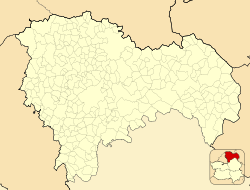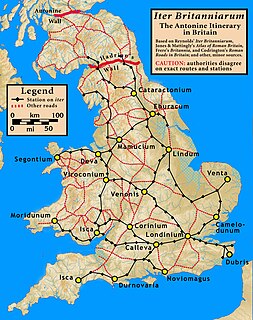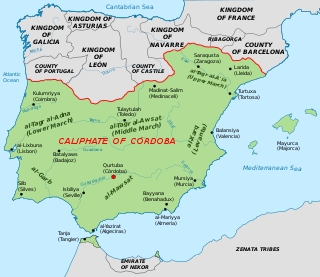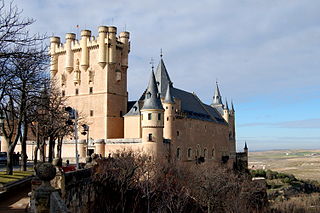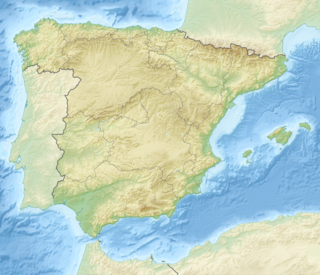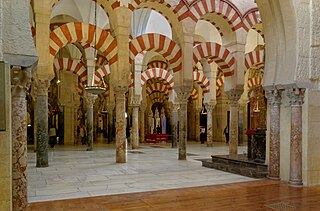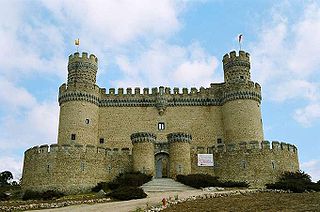It has been requested that the title of this article be changed to Guadalajara, Spain . Please see the relevant discussion on the discussion page. The page should not be moved unless the discussion is closed; summarizing the consensus achieved in support of the move. |
This article may be expanded with text translated from the corresponding article in Spanish. (October 2012)Click [show] for important translation instructions.
|
Guadalajara | |
|---|---|
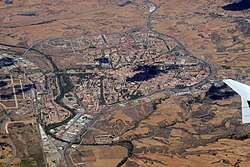 | |
| Coordinates: 40°38′1.36″N3°10′2.62″W / 40.6337111°N 3.1673944°W Coordinates: 40°38′1.36″N3°10′2.62″W / 40.6337111°N 3.1673944°W | |
| Country | |
| Autonomous community | |
| Province | Guadalajara |
| Comarca | La Alcarria |
| Judicial district | Guadalajara |
| Municipality | Guadalajara |
| Founded | 8th century; possible prior Iberian origin |
| Government | |
| • Mayor | Antonio Román Jasanada (PP) |
| Area | |
| • Total | 235.51 km2 (90.93 sq mi) |
| Elevation | 708 m (2,323 ft) |
| Highest elevation | 972 m (3,189 ft) |
| Lowest elevation | 620 m (2,030 ft) |
| Population (2017) | |
| • Total | 84,145 |
| • Density | 360/km2 (930/sq mi) |
| Demonyms | Guadalajareño/a, arriacense, caracense and alcarreño/a (common throughout the region of La Alcarria) |
| Time zone | UTC+1 (CET) |
| • Summer (DST) | UTC+2 (CEST) |
| Postal code | 19001–5 |
| Dialing code | 949 |
| Climate | Csa |
| Website | Official website |
Guadalajara ( /ˌɡwɑːdələˈhɑːrə/ ; Spanish pronunciation: [ɣwaðalaˈxaɾa] [1] ) is a city and municipality in the autonomous community of Castilla–La Mancha, Spain, and in the natural region of La Alcarria. It is the capital of the Province of Guadalajara. It is located roughly 60 kilometres (37 miles) northeast of Madrid on the Henares River, and has a population of 84,803 (2012).

A municipality is usually a single administrative division having corporate status and powers of self-government or jurisdiction as granted by national and regional laws to which it is subordinate. It is to be distinguished (usually) from the county, which may encompass rural territory or numerous small communities such as towns, villages and hamlets.

In Spain, an autonomous community is a first-level political and administrative division, created in accordance with the Spanish constitution of 1978, with the aim of guaranteeing limited autonomy of the nationalities and regions that make up Spain.

Castilla–La Mancha is an autonomous community of Spain. Comprised by the provinces of Albacete, Ciudad Real, Cuenca, Guadalajara and Toledo, it was created in 1982. It is bordered by Castile and León, Madrid, Aragon, Valencia, Murcia, Andalusia, and Extremadura. It is one of the most sparsely populated of Spain's regions. Albacete is the largest and most populous city. Its capital city is Toledo, and its judicial capital city is Albacete.
Contents
- History
- Pre-Moorish Invasion and settlements
- Al-Andalus foundation
- Christian occupation and Middle Ages
- Renaissance
- Contemporary times
- Mayoralty
- Main sights
- Monuments
- Architecture in the districts
- Miscellaneous
- Twin towns – sister cities
- Climate
- Gallery
- Transport
- Notable people
- See also
- References
- External links


